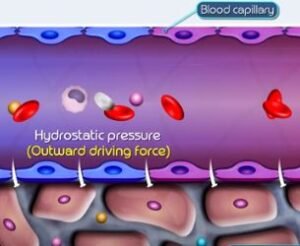Define edema?
Edema is defined as the excessive or uncontrolled collection of fluid within interstitial space and/air body cavities.
The net movement of fluid between plasma & interstitium governed by hydrostatic pressure & plasma oncotic pressure.

Hemodynamic Disorders
In edema, approximately 60% of lean body weight is water, 2/3rd of which is intracellular and the remainder is in extracellular compartments, mostly as interstitial fluid; only 5% of total body water is in blood plasma.
Edema in different body cavities are variously designated;
- In pleural cavity: Hydrothorax (pleural effusion)
- In pericardium: Hydropericardium (pericardial effusion)
- In peritoneum: Hydroperitoneum (ascites)
- Anasarca is serious & generalized edemas with profound subcutaneous tissue swelling.
Types
- Transudate
- Protein poor in fluid and low LDH
- Specific Gravity- 1.012
- It is Clear and It is caused by;
- Increased hydrostatic pressure and decreased osmotic pressure
- It is seen in patients suffering from heart failure, renal failure, hepatic failure, and certain forms of malnutrition.
- Exudate
- Protein-rich in this fluid and high LDH
- Specific gravity-1.020
- It is cloudy due to the presence of white cells
- It is caused by increased vascular permeability (Inflammation).
Causes
- Increased hydrostatic pressure
- Reduced plasma osmotic pressure (hypoproteinemia)
- Lymphatic obstruction
- Sodium and water retention
- Inflammation
- Increased hydrostatic pressure
- Impaired venous return
- Congestive heart failure
- Constrictive pericarditis
- Liver cirrhosis
- Venous obstruction or compression
- Thrombosis
- External pressure (e.g. mass)
- Lower extremity inactivity with prolonged dependency
- Arteriolar dilation Heat
- Neurohumoral dysregulation
- Reduced plasma osmotic pressure (Hypoproteinemia)
- It occurs when albumin, the major plasma protein, is not synthesized in adequate amounts as in severe liver diseases (e.g., cirrhosis or protein malnutrition)
- It is lost from the circulation as in nephrotic syndrome
- It lessened plasma osmotic pressure when fluid goes to interstitial tissues.
- Protein-losing glomerulopathies (nephrotic syndrome)
- Liver cirrhosis (ascites)
- Malnutrition
- Protein-losing gastroenteropathy
- Lymphatic obstruction
- Inflammatory
- Parasitic infestation
- Elephantiasis:
- Lymphatic obstruction due to substantial inguinal lymphatic & lymph node fibrosis then edema of the external genitalia & lower limbs and finally elephantiasis occurs.
- Neoplastic condition
- Postsurgical ( e.g. modified radical mastectomy for carcinoma of breast)
- Post-irradiation
- Sodium and water retention
- Excessive salt intake with renal insufficiency
- Increased tubular reabsorption of sodium
- Renal hypoperfusion
- Increased renin-angiotensin-aldosterone secretion
- Inflammation
- Acute inflammation
- Chronic inflammation
- Angiogenesis
Morphology of edema
- Gross:
- Distribution is influenced by gravity
- As independent edema (e.g.’ the legs when standing, the sacrum when recumbent)
- Pitting edema
- Lungs (pulmonary edema)
- The cut, section shows heavy boggy lungs, & frothy blood-tinged fluid.
- Brain- swollen with narrowed sulci and distended gyri
- Periorbital edema-severe renal disease
- Microscopically:
- Clearing & separation of extracellular matrix & swelling of subtle.
Clinical features
- Subcutaneous edema
- It is a signal of underlying cardiac disease or renal disease; impairment wound healing, clearance of infections
- Pulmonary edema
- Left ventricular failure; Renal failure
- Impaired oxygen diffusion
- Favors bacterial infection
- Left ventricular failure; Renal failure
- Body cavities effusion
- Pleural effusion- a collapse of lung parenchyma
- Ascites- a bacterial infection
- Pericardial effusion- heart failure
- Cerebral edema
- Herniation of brain material through the foramen magnum- injure medullary centers & death.